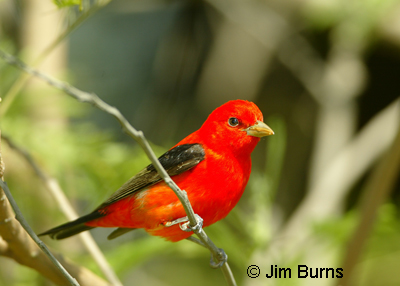
Have you had your morning coffee yet? The only connection you may see between coffee and birds is the obvious one--to be out there at the crack o' dawn when the birds are most active, you need that wake-up jolt that comes in a cup of caffeine. But there's another connection, much less evident, much more important.
September is the peak of southbound songbird migration. Have you ever thought about where your migrant songbirds are going and how they're going to survive when they get there? Most of them are going to where your coffee is coming from, and they need trees and insects there. If you want to continue enjoying their spring and fall passages, I'd like you to consider purchasing only "shade-grown" coffee.
Originally, in the wild, coffee was an understory plant. "Shade-grown" refers to coffee that is cultivated in the traditional way--beneath a canopy of trees, typically leguminous species which fix nitrogen into the soil. Let's connect the dots between shade-grown coffee and songbirds.
It is estimated that up to 10 billion birds breed in North America, then migrate through the funnel that is Mexico/Central America to winter in Latin America. In the late twentieth century two factors adversely impacted our songbirds' winter habitat there--slash-and-burn agriculture and the invasion of leaf rust. Together these two have led to vast and rapid deforestation in Latin America, the latter because it induced many large coffee growers to convert their operations to sun coffee grown with no canopy, under full sunlight, using fertilizers, herbicides, and pesticides--an ecological desert with no trees, no insects and, thus, no birds.
Here are three random statistics along our dot line which will surprise, if not shock: by one estimate, over forty percent of Latin America's permanent cropland is devoted to coffee; in 1999 60% of the remaining forest habitat in the entire country of El Salvador was on shade-grown coffee plantations; during the time of greatest decline in shade-grown coffee, U.S. Fish and Wildlife surveys documented a songbird decline up to 3% annually. The shade-grown coffee movement by consumers has not yet reached the critical mass of the dolphin-free tuna campaign of the late 1980s, but time has come today.
In the Phoenix area shade-grown coffee is available at Starbucks, Trader Joe's, and the Sunflower Markets. Coffees carrying "organic" and "fair trade" labels imply smaller, family owned plantations operating in the traditional way under a forest canopy, but there is much obfuscation in labeling practices. To be sure, look for the "shade-grown" label.
Flip to the second half of your field guide and savor the color plates of some of our most endangered songbirds--wood thrush, black-throated blue warbler, Blackburnian warbler, cerulean warbler, scarlet tanager. Loss of winter habitat is a primary cause of precipitous decline in these and other songbird species. Birds need coffee as much as you do, but they need the canopy that protects and nourishes the shade-grown varieties. Would it still be fall migration if there were no songbirds to migrate?